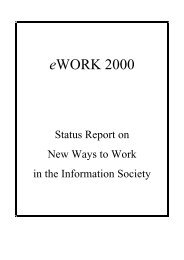Proceedings of 8th European Assembly on telework (Telework2001)
Proceedings of 8th European Assembly on telework (Telework2001)
Proceedings of 8th European Assembly on telework (Telework2001)
Create successful ePaper yourself
Turn your PDF publications into a flip-book with our unique Google optimized e-Paper software.
91Usability compatibility. Terminals, applicati<strong>on</strong>s, services, and sometimes even service c<strong>on</strong>tentscome from different origins. They may be technically compatible, but technical compatibility isdifferent from ‘usability compatibility’. The service may be optimized to a completely differentterminal – or technology – that you have. You need to rec<strong>on</strong>figure the device for the c<strong>on</strong>necti<strong>on</strong>,and perhaps remove the c<strong>on</strong>figurati<strong>on</strong> when back in normal use. The features that are coded into thememory <str<strong>on</strong>g>of</str<strong>on</strong>g> a product can be presented in a clear manner in the user interface. The user <strong>on</strong>ly needsto browse through the menus and check what there is to choose from. In situati<strong>on</strong>s then a serviceis dependent <strong>on</strong> the cooperati<strong>on</strong> <str<strong>on</strong>g>of</str<strong>on</strong>g> several devices and different communicati<strong>on</strong> technologies theopti<strong>on</strong>s cannot be presented to the user. Often the user needs to know in advance what to look for– and where to look it.Adaptati<strong>on</strong> for low UI bandwidthFlexibility is <strong>on</strong>e <str<strong>on</strong>g>of</str<strong>on</strong>g> the most important requirements in developing telecommunicati<strong>on</strong> soluti<strong>on</strong>sto support distributed work. There are tasks that <strong>on</strong>e can pack into a briefcase, go wherever <strong>on</strong>eprefers, complete the tasks and come back. However, in practice everything that will be neededduring a task completi<strong>on</strong> is seldom known in the beginning. New informati<strong>on</strong> will be requiredduring the work flow and even the nature <str<strong>on</strong>g>of</str<strong>on</strong>g> that material can be specified <strong>on</strong>ly as the need emerges.The results are neither delivered as a single unquesti<strong>on</strong>able package, but different versi<strong>on</strong>s needto be sent for reviews, or the actual output is a combinati<strong>on</strong> <str<strong>on</strong>g>of</str<strong>on</strong>g> several individual c<strong>on</strong>tributi<strong>on</strong>s.Further <strong>on</strong>, even efficient informati<strong>on</strong> transfer is not enough to meet the flexibility needs <str<strong>on</strong>g>of</str<strong>on</strong>g> manybusiness tasks. Instead <str<strong>on</strong>g>of</str<strong>on</strong>g> sending and commenting produced documents, the work needs to bed<strong>on</strong>e in closer cooperati<strong>on</strong>. A team <str<strong>on</strong>g>of</str<strong>on</strong>g> experts may be working <strong>on</strong> the same object each <strong>on</strong>e beingaware <str<strong>on</strong>g>of</str<strong>on</strong>g> what the others are doing. Everybody needs to know about the others for fluent coupling.Another angle to the flexibility <str<strong>on</strong>g>of</str<strong>on</strong>g> working is the locati<strong>on</strong> <str<strong>on</strong>g>of</str<strong>on</strong>g> performing the tasks. The traditi<strong>on</strong>almodel is that people came where the work is. Wired telecommunicati<strong>on</strong> allows people to takethe work where they are. They can work where they prefer, as l<strong>on</strong>g as they prefer to work in thesame locati<strong>on</strong> all the time. The ultimate step al<strong>on</strong>g this dimensi<strong>on</strong> is that working is essentiallylocati<strong>on</strong> independent. People would be able to work wherever they want – or need - and changetheir preferences.Aiming at the flexibility calls for tools that enable informati<strong>on</strong> and c<strong>on</strong>text sharing and mobility.With these kinds <str<strong>on</strong>g>of</str<strong>on</strong>g> tools flexibility can be realized <strong>on</strong> two levels: <strong>on</strong> <strong>on</strong>e hand they allow individualdifferences between users and pr<str<strong>on</strong>g>of</str<strong>on</strong>g>essi<strong>on</strong>s, and <strong>on</strong> the other hand they let the individuals to choosethe most appropriate and preferable ways <str<strong>on</strong>g>of</str<strong>on</strong>g> work in all situati<strong>on</strong>s.What does this kind <str<strong>on</strong>g>of</str<strong>on</strong>g> flexibility mean from the user interface design angle? On <strong>on</strong>e hand theuser needs efficiency: versatile input facilities, large screens and fast c<strong>on</strong>necti<strong>on</strong>s for usabilityand comfort. On the other hand the user needs to have an access to the same – or compatible –services and data when utilizing the freedom to move. Apparently the physical terminals when <strong>on</strong>the move are different from the <strong>on</strong>es that are optimized for stati<strong>on</strong>ary efficiency, and the differentinterfaces have different communicati<strong>on</strong> bandwidths. Adapting for low user interface bandwidthis <strong>on</strong>e <str<strong>on</strong>g>of</str<strong>on</strong>g> the most crucial challenges influencing the users’ experiences and their acceptance <str<strong>on</strong>g>of</str<strong>on</strong>g>mobile services.








